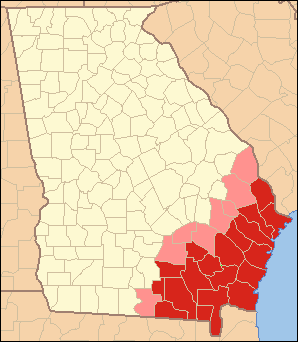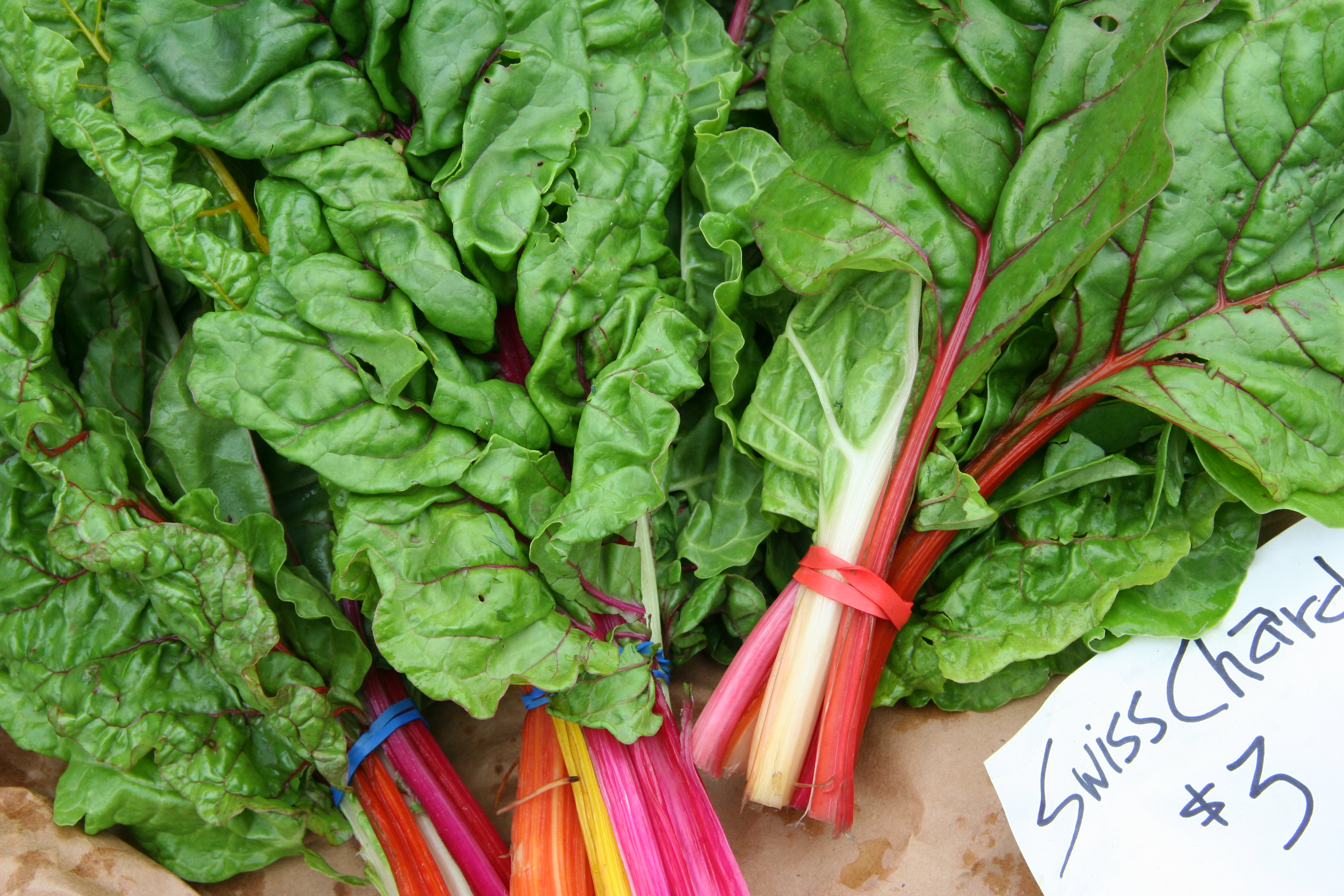|
Hoppin' John
Hoppin' John, also known as Carolina peas and rice, is a peas and rice dish served in the Southern United States. It is made with cowpeas (mainly, Black-eyed peas, Sea Island red peas in the Sea Islands and Iron and clay peas in the Southeast US) and rice, chopped onion, and sliced bacon, seasoned with salt. Some recipes use ham hock, fatback, country sausage, or smoked turkey parts instead of bacon. A few use green peppers or vinegar and spices. Smaller than black-eyed peas, field peas are used in the South Carolina Lowcountry and coastal Georgia; black-eyed peas are the norm elsewhere. In the southern United States, eating Hoppin' John on New Year's Day is thought to bring a prosperous year filled with luck. The peas are symbolic of pennies or coins, and a coin is sometimes added to the pot or left under the dinner bowls. Collard greens, mustard greens, turnip greens, chard, kale, cabbage and similar leafy green vegetables served along with this dish are supposed to furth ... [...More Info...] [...Related Items...] OR: [Wikipedia] [Google] [Baidu] |
Southern United States
The Southern United States (sometimes Dixie, also referred to as the Southern States, the American South, the Southland, or simply the South) is a geographic and cultural region of the United States of America. It is between the Atlantic Ocean and the Western United States, with the Midwestern and Northeastern United States to its north and the Gulf of Mexico and Mexico to its south. Historically, the South was defined as all states south of the 18th century Mason–Dixon line, the Ohio River, and 36°30′ parallel.The South . ''Britannica.com''. Retrieved June 5, 2021. Within the South are different subregions, such as the |
Coastal Georgia
Southeast Georgia's Lower Coastal Plain is a subregion that encompasses the lowest-lying areas of the Atlantic coastal plain in the state, containing barrier islands, marshes, and swampy lowlands, as well as flat plains and low terraces. It differs from Georgia's Upper Coastal Plain in that it is lower in elevation with less relief and wetter soils. The United States Environmental Protection Agency defines the Lower Coastal Plain as an ecoregion, part of the larger, interstate Southern Coastal Plain. Within the subregion flow the major rivers the Altamaha, Ogeechee, Saint Marys, Savannah, Satilla, and Suwannee (all of which, except the Suwannee River, empty into the Atlantic Ocean); the Saint Marys and Suwannee rivers have their origins in the Okefenokee Swamp. The Coastal Plain is also the home to Savannah the first capitol which was declared in 1733. The subregion is synonymous with coastal Georgia, and contains the counties of Atkinson, Bacon, Brantley, Camden, Char ... [...More Info...] [...Related Items...] OR: [Wikipedia] [Google] [Baidu] |
Peas
The pea is most commonly the small spherical seed or the seed-pod of the flowering plant species ''Pisum sativum''. Each pod contains several peas, which can be green or yellow. Botanically, pea pods are fruit, since they contain seeds and develop from the ovary of a (pea) flower. The name is also used to describe other edible seeds from the Fabaceae such as the pigeon pea (''Cajanus cajan''), the cowpea (''Vigna unguiculata''), and the seeds from several species of ''Lathyrus''. Peas are annual plants, with a life cycle of one year. They are a cool-season crop grown in many parts of the world; planting can take place from winter to early summer depending on location. The average pea weighs between 0.1 and 0.36 gram. The immature peas (and in snow peas the tender pod as well) are used as a vegetable, fresh, frozen or canned; varieties of the species typically called field peas are grown to produce dry peas like the split pea shelled from a matured pod. These are the ba ... [...More Info...] [...Related Items...] OR: [Wikipedia] [Google] [Baidu] |
Stew
A stew is a combination of solid food ingredients that have been cooked in liquid and served in the resultant gravy. A stew needs to have raw ingredients added to the gravy. Ingredients in a stew can include any combination of vegetables and may include meat, especially tougher meats suitable for slow-cooking, such as beef, pork, lamb, poultry, sausages, and seafood. While water can be used as the stew-cooking liquid, stock is also common. A small amount of red wine is sometimes added for flavour. Seasoning and flavourings may also be added. Stews are typically cooked at a relatively low temperature ( simmered, not boiled), allowing flavours to mingle. Stewing is suitable for the least tender cuts of meat that become tender and juicy with the slow moist heat method. This makes it popular in low-cost cooking. Cuts having a certain amount of marbling and gelatinous connective tissue give moist, juicy stews, while lean meat may easily become dry. Stews are thickened by ... [...More Info...] [...Related Items...] OR: [Wikipedia] [Google] [Baidu] |
Travel Literature
The genre of travel literature encompasses outdoor literature, guide books, nature writing, and travel memoirs. One early travel memoirist in Western literature was Pausanias, a Greek geographer of the 2nd century CE. In the early modern period, James Boswell's ''Journal of a Tour to the Hebrides'' (1786) helped shape travel memoir as a genre. History Early examples of travel literature include the ''Periplus of the Erythraean Sea'' (generally considered a 1st century CE work; authorship is debated), Pausanias' ''Description of Greece'' in the 2nd century CE, ''Safarnama'' (Book of Travels) by Nasir Khusraw (1003-1077), the '' Journey Through Wales'' (1191) and '' Description of Wales'' (1194) by Gerald of Wales, and the travel journals of Ibn Jubayr (1145–1214), Marco Polo (1254–1354), and Ibn Battuta (1304–1377), all of whom recorded their travels across the known world in detail. As early as the 2nd century CE, Lucian of Samosata discussed history an ... [...More Info...] [...Related Items...] OR: [Wikipedia] [Google] [Baidu] |
Frederick Law Olmsted
Frederick Law Olmsted (April 26, 1822August 28, 1903) was an American landscape architect, journalist, social critic, and public administrator. He is considered to be the father of landscape architecture in the USA. Olmsted was famous for co-designing many well-known urban parks with his partner Calvert Vaux. Olmsted and Vaux's first project was Central Park, which led to many other urban park designs, including Prospect Park in what was then the City of Brooklyn (now the Borough of Brooklyn in New York City) and Cadwalader Park in Trenton, New Jersey. He headed the preeminent landscape architecture and planning consultancy of late nineteenth-century America, which was carried on and expanded by his sons, Frederick Jr. and John C., under the name Olmsted Brothers. Other projects that Olmsted was involved in include the country's first and oldest coordinated system of public parks and parkways in Buffalo, New York; the country's oldest state park, the Niagara Reservation in ... [...More Info...] [...Related Items...] OR: [Wikipedia] [Google] [Baidu] |
Cornbread
Cornbread is a quick bread made with cornmeal, associated with the cuisine of the Southern United States, with origins in Native American cuisine. It is an example of batter bread. Dumplings and pancakes made with finely ground cornmeal are staple foods of the Hopi people in Arizona. The Hidatsa people of the Upper Midwest call baked cornbread ''naktsi''. Cherokee and Seneca tribes enrich the basic batter, adding chestnuts, sunflower seeds, apples or berries, and sometimes combining beans or potatoes with the cornmeal. Modern versions of cornbread are usually leavened by baking powder. History Native people in the Americas began using corn (maize) and ground corn as food thousands of years before Europeans arrived in the New World. First domesticated in Mexico around six thousand years ago, corn was introduced to what is now the United States between three thousand and one thousand years ago. Native cooks developed a number of recipes based on corn, including cornbread ... [...More Info...] [...Related Items...] OR: [Wikipedia] [Google] [Baidu] |
Cabbage
Cabbage, comprising several cultivars of ''Brassica oleracea'', is a leafy green, red (purple), or white (pale green) biennial plant grown as an annual vegetable crop for its dense-leaved heads. It is descended from the wild cabbage ( ''B. oleracea'' var. ''oleracea''), and belongs to the "cole crops" or brassicas, meaning it is closely related to broccoli and cauliflower (var. ''botrytis''); Brussels sprouts (var. ''gemmifera''); and Savoy cabbage (var. ''sabauda''). A cabbage generally weighs between . Smooth-leafed, firm-headed green cabbages are the most common, with smooth-leafed purple cabbages and crinkle-leafed savoy cabbages of both colours being rarer. Under conditions of long sunny days, such as those found at high northern latitudes in summer, cabbages can grow quite large. , the heaviest cabbage was . Cabbage heads are generally picked during the first year of the plant's life cycle, but plants intended for seed are allowed to grow a second year and must ... [...More Info...] [...Related Items...] OR: [Wikipedia] [Google] [Baidu] |
Kale
Kale (), or leaf cabbage, belongs to a group of cabbage (''Brassica oleracea'') cultivars grown for their edible leaves, although some are used as ornamentals. Kale plants have green or purple leaves, and the central leaves do not form a head (as with headed cabbage). Kales are considered to be closer to wild cabbage than most of the many domesticated forms of ''Brassica oleracea''. Etymology ''Kale'' originates from Northern Middle English ''cale'' (compare Scots ''kail'' and German ''Kohl'') for various cabbages. The ultimate origin is Latin ''caulis'' 'cabbage'. History Kale originated in the eastern Mediterranean and Anatolia, where it was cultivated for food beginning by 2000 BCE at the latest. Curly-leaved varieties of cabbage already existed along with flat-leaved varieties in Greece in the 4th century BC. These forms, which were referred to by the Romans as Sabellian kale, are considered to be the ancestors of modern kales. The earliest record of cabbages ... [...More Info...] [...Related Items...] OR: [Wikipedia] [Google] [Baidu] |
Chard
Chard or Swiss chard (; ''Beta vulgaris'' subsp. ''vulgaris'', Cicla Group and Flavescens Group) is a green leafy vegetable. In the cultivars of the Flavescens Group, the leaf stalks are large and often prepared separately from the leaf blade; the Cicla Group is the leafy spinach beet. The leaf blade can be green or reddish; the leaf stalks are usually white or a colorful yellow or red. Chard, like other green leafy vegetables, has highly nutritious leaves, making it a popular component of healthy diets. Chard has been used in cooking for centuries, but because it is the same species as beetroot, the common names that cooks and cultures have used for chard may be confusing; it has many common names, such as silver beet, perpetual spinach, beet spinach, seakale beet, or leaf beet. Classification Chard was first described in 1753 by Carl Linnaeus as ''Beta vulgaris'' var. ''cicla''. [...More Info...] [...Related Items...] OR: [Wikipedia] [Google] [Baidu] |
Turnip Greens
The turnip or white turnip (''Brassica rapa'' subsp. ''rapa'') is a root vegetable commonly grown in temperate climates worldwide for its white, fleshy taproot. The word ''turnip'' is a compound of ''turn'' as in turned/rounded on a lathe and ''neep'', derived from Latin ''napus'', the word for the plant. Small, tender varieties are grown for human consumption, while larger varieties are grown as feed for livestock. In Northern England, Scotland, Ireland, Cornwall and parts of Canada (Quebec, Newfoundland, Manitoba and the Maritimes), the word ''turnip'' (or ''neep'') often refers to rutabaga, also known as ''swede'', a larger, yellow root vegetable in the same genus (''Brassica''). Description The most common type of turnip is mostly white-skinned apart from the upper , which protrude above the ground and are purple or red or greenish where the sun has hit. This above-ground part develops from stem tissue, but is fused with the root. The interior flesh is entirely white. ... [...More Info...] [...Related Items...] OR: [Wikipedia] [Google] [Baidu] |








.jpg)